

Lucas Oil Stadium: A Well-Oiled AV Machine
Though well-known in racing circles because of its omnipresent logo, Lucas Oil Products was hardly a household name in Indianapolis two years ago. So it began to formulate a marketing plan that would take full advantage of audiovisual technology while meeting expectations for a state-of-the-art facility. Digital signage would be a big part of building brand awareness.
Lucas called in Sensory Technologies in fall 2007 when it ran into problems integrating AV in the kiosks. Though it had a clear goal of building brand awareness, Lucas wasn’t sure how to translate it into an AV experience aside from requiring high-definition displays. “We probably did six months of consulting work with them before we even specified our first design,” Nicholson recalls.
CHALLENGE: Get a client’s message out in a loud, crowded football stadium.
SOLUTION: Broadcast-quality digital signage streams content from a remote location to a local server. From there it rides Cat-5 to an HD video wall and kiosks in a sound-reinforced pavilion.
The videowall was one thing. Sensory Technologies also had to integrate a robust sound reinforcement system into the cavernous stadium plaza.
Credit: Sensory Technologies
Though well-known in racing circles because of its omnipresent logo, Lucas Oil Products was hardly a household name in Indianapolis two years ago, despite securing naming rights to the new pro football stadium being built for the city’s beloved Colts. So it began to formulate a marketing plan that would take full advantage of audiovisual technology while meeting expectations for a state-of-the-art facility.
Digital signage would be a big part of building brand awareness. “They were looking for the ability to display and market their racing division,” says Andrea Nicholson, business development manager at Indianapolis-based designer and integrator Sensory Technologies.
The stadium’s owners, the City of Indianapolis, had the unusual strategy of giving the top eight corporate sponsors their own marketing niches on the main concession level. The Charlotte, N.C.-based architectural firm Wagner Murray Architects worked with each sponsor to design workable, code-compliant spaces. The result–the 30,000-square-foot Lucas Oil Plaza–is a sight to behold.
Racing is the main motif in the Plaza and includes two dragsters that frame a giant 4×4 videowall. In addition, two oil-bottle-shaped, 10-foot kiosks include 52-inch touch-screen monitors with interactive content about racing and the oil industry; another monitor is devoted solely to digital signage.
While all this is set up in a stadium in the Midwest, Lucas Oil producers at company headquarters in Corona, Calif., manage and control all content for the videowall and kiosks using a digital signage platform from X2O Media (see sidebar). But we’re getting ahead of ourselves.
Slippery Slopes
A Crestron TPMX-8X wireless touch panel is used to control the AV in Lucas Oil Plaza. The control system itself is in a rack in a nearby closet that’s secured with a fingerprint scanner.
Credit: Sensory Technologies
By early spring 2008, the bottles were built, and Sensory concluded it needed a videowall, after ruling out a projection system because of too much ambient light. It looked at 6mm LED displays but decided they were too expensive, opting instead for 16 52-inch NEC LCD5220-AV monitors in the 4×4 configuration–at a quarter the cost. Nicholson says Sensory chose that model of NEC display for its thin, 19mm bezel, which avoids the patchwork effect that wider-bezeled monitors can produce.
According to Nick Iorfida, district sales manager for NEC Display’s Midwest region, the specification originally called for 57-inch models with significantly wider bezels–around 2 inches. But then NEC introduced the thin-bezel model for half the cost, albeit on a slightly smaller monitor. “The gap between the monitors is minimal, and the video image is impactful and seamless,” Iorfida says.
Each monitor has a videowall processor that lets installers program the screen’s position within the array from a standard, handheld remote. The wall typically shows videos in full, 1080p HD, and there is a 192-inch-wide by 9-inch-high LED ticker along the bottom.
X20 Drives Signage Cross-Field and Cross-Country
Credit: Sensory Technologies
Xpresenter Player from X20 Media is the engine that drives the broadcast-quality digital signage at Lucas Oil Stadium. Essentially a live graphics-rendering engine that runs on a run-of-the-mill server in a nearby closet, Xpresenter has been to even loftier places, having powered CNN’s Super Tuesday election-night tallies as well as the graphics shown on ESPN and Olympic telecasts.
“The back-end engine was taking in all the data and turning it into graphics on the screen,” says Greg Burgess, president of JB&A Distribution, the consultant and X2O distributor. “It’s really data being presented in 3D graphics.”
Project integrator Sensory Technologies was sold on X2O based on the quality if its rendered video, which was critical to meeting Lucas Oil’s project goals: playing high-definition videos of its racing events without loss of quality, typically a challenge in digital signage.
“The X20 rendering engine does that inherently,” says Maria Casey, JB&A’s sales manager for the project. “It renders it just like a broadcast, just like national television at 30 frames per second.”
JB&A sent an engineer to Lucas’ Corona, Calif., headquarters to train its content-creation group on Xpresenter and digital signage best practices. Burgess hopes the Lucas team will diversify beyond racing videos. “It’s a wide-open platform and we can go in any direction with it,” he says.
Sensory worked on the installation at the same time it was involved with other projects at the stadium. Working around construction was a challenge, and the incomplete status of the stadium’s retractable roof and now-iconic giant window presented weather problems. Monitors usually had to be installed in a single day because leaving them on the floor made them susceptible to water damage. “We couldn’t go in there,” says Sensory project manager Ben Foulke. “We’re talking about floors being cured.”
AV elements were sometimes installed out of optimal sequence. “We had the wall up before we could get power to it,” Foulke says. Adds Nicholson: “We had situations where they were pulling power and we were in the lift pulling data through. We were right on their heels with our project. We put in 20-hour days sometimes putting monitors up and getting things done to work with other trades.”
Elevating the videowall was a major challenge. The monitors rest securely in a custom frame from Peerless Industries. Because the plaza is partly outdoors, the frame and videowall had to be able to sustain high winds and a wide temperature range, Nicholson says. Although the wall appears to rest on beams, it is suspended from the ceiling with aircraft cable carefully specified by a structural engineer. The beams themselves just prevent swaying, Foulke says.
Custom-designed covering keeps the electronics out of sight, while rear flaps allow servicing. “It all fully encompasses the back of the monitor to create a black box,” Nicholson says.
Similar black boxes surround 52-inch NEC LCDs that hide air-conditioning units halfway up stadium escalators, their screens showing an exploded view of a Hemi engine.
The Peerless frame holds power supplies for the monitors, each of which has a MultiView AK600DP dual-port receiver from Magenta Research. The Magenta MultiView UTx Universal Transmitter sits in the equipment rack, which is located in the nearby corporate space of another Sensory client (a necessary compromise because there wasn’t a wall between Lucas Plaza and the stadium seats).
“We ended up using Cat-5 for everything because you could used Cat-5 to the server and you do VGA from there,” Foulke says. “We couldn’t go that distance with VGA.”
The rack also holds a Crestron CP2E Ethernet control system that talks to the Crestron TPMC-8X wireless touch panel used inside the pavilion. Nicholson says that given the high traffic of the stadium, it was imperative to secure the closet, so a fingerprint scanner authenticates each system operator. After pressing the all-on button, the operator checks to ensure all monitors are working. “We have second and third backup plans, should they need to be put in place,” Nicholson says. For example, backup DVD players in each kiosk could deliver content if the digital signage server and video-distribution system fails, she says. A DVD player in the rack provides similar backup for the videowall.
The kiosks are portable, thanks to lockable casters and floor plates for power and data connections. Foulke says the kiosks must be moved for events like the Super Bowl that bring their own set of corporate sponsors.
Lucas Oil Stadium: A Well-Oiled AV Machine
Though well-known in racing circles because of its omnipresent logo, Lucas Oil Products was hardly a household name in Indianapolis two years ago. So it began to formulate a marketing plan that would take full advantage of audiovisual technology while meeting expectations for a state-of-the-art facility. Digital signage would be a big part of building brand awareness.
And the Crowd Roars
Of course, the Lucas Oil Plaza isn’t only a visual experience. It would be an understatement to say the plaza’s sound system has a little competition for fans’ attention, sitting as it does underneath the seats of a football stadium with its own loudspeakers that blare game-related audio and PA announcements. To say nothing of the audio from other corporate sponsors on the concession level.
Sensory considered 6mm LED technology for the Lucas Oil Plaza, but opted for 16 52-inch NEC LCD displays for a quarter of the cost of LED.
Credit: Sensory Technologies
“We had to design [our system] to mute when the PA came on and un-mute when the system kicked off,” Nicholson says. The resulting sound-reinforcement solution is an impressive technological feat that manages to produce quality audio in a huge, acoustically inhospitable environment of 25- to 60-foot concrete walls. “When you’re in this space, you feel like you’re in a concert hall,” she adds.
Two arrays, each consisting of a pair of Klipsch KI362 three-way speaker cabinets and KI215 subwoofers, fly on either side of the videowall that covers the entrance of the pavilion. Eight more KI362s and two KI215s are distributed along the concourse on either side of a horseshoe-shaped stage that features musical acts. Three KI102 near-field cabinets fill the area directly in front of the stage. Every cabinet is bi-amped.
Equipment List
Below is a partial list of the equipment installed by Sensory Technologies at Lucas Oil Stadium in Indianapolis.
- Biamp AudiaFlex digital audio platform
- Crestron TPMC-8X Isys I/O 8.4-inch Wi-Fi wireless touch panel
- Crestron-CP2E compact control system with Ethernet
- Crown I-Tech IT-4000 and IT-6000 amplifiers
- Extron SW2-RGBHV switcher
- Extron IN1502 scaler
- Klipsch KI362 3-way speakers
- Klipsch KI215 subwoofers
- Klipsch arrays with two KI362 cabinets and one KI215 subwoofer
- Magenta Research MultiView 9D 1×9 Cat-5 distribution amps
- Magenta MultiView UTx universal transmitter
- Magenta MultiView AK600DP dual-port receivers
- Middle Atlantic racks and surge protection
- NEC LCD5220-AV 52-inch LCD displays
- Peerless Industries custom and pull-out video wall mounts
- X2O Xpresenter digital signage system
Source: Sensory Technologies
The system is powered by Crown I-Tech amplifiers–IT-4000 models for the KI362s and KI102s and IT-6000s for the KI215s. Sensory says it chose the I-Techs for their high efficiency, power output, and internal DSPs. The DSPs handled speaker tunings, crossover points, and component alignments. The system also uses a Biamp AudiaFlex for simple audio routing and level control of the digital signage system and presentation sources when the stage is not in use.
During setup, audio engineers walked the room with a wireless tablet PC to monitor and adjust the parameters of each amplifier by zone. Dimensions and speaker angles were precisely calculated and echo cancellation adjusted. “Our sound engineer basically spent the night there for a week,” Foulke says. “This is all going on while other trades are still working in the space.”
Kiosk sound also had to be adjusted to coexist in the complex aural environment. Nicholson says their directionalized speakers keep the sound focused on people standing near the screens. “When you walk four feet to the left, you don’t hear it anymore,” she explains.
When asked about future plans for the space, Nicholson says she has heard of none, and for good reason. “Lucas went all out in phase one,” she says. “They did everything they wanted to do. Some of the other sponsors held back for a later phase.”
The audiovisual impact of the place is testament enough. “You walk into this space and it’s Lucas Oil overload,” Nicholson says. “You forget that you’re at a football game.” AV
David Essex is a freelance technology writer based in Peterborough, N.H.










